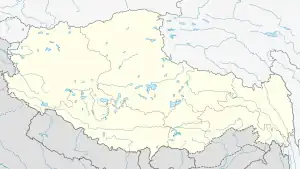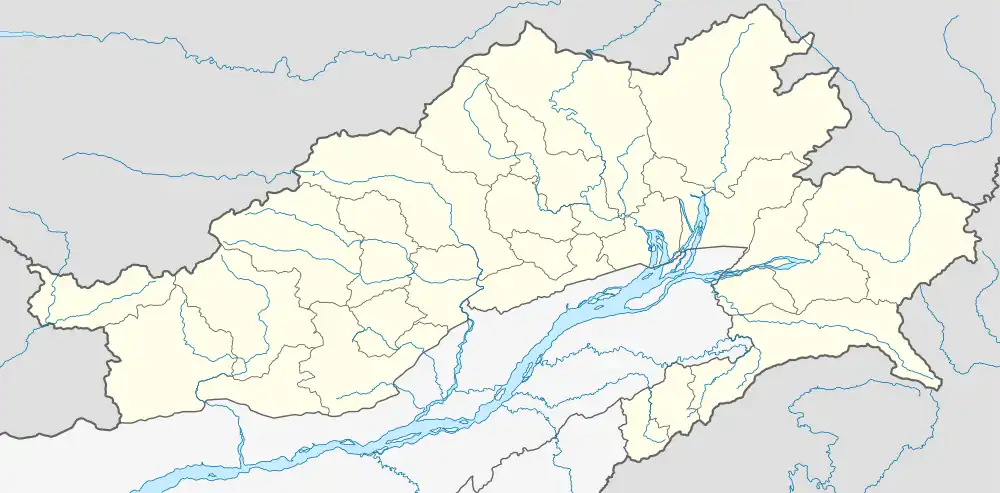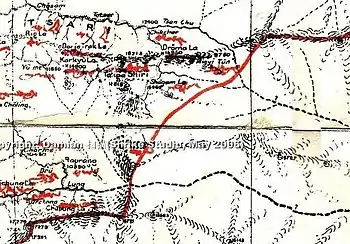Migyitun
Migyitun (Tibetan: ཀློ་མི་ཁྱིམ་བདུན, Wylie: klo mi khyim bdun, THL: lo mi khyim dün),[1] also called Tsari (Tibetan: རྩ་རི, Wylie: rtsa ri) or Zhari (Chinese: 扎日乡), is a town in the Lhöntse County of Tibet's Shannan Prefecture. It is on the banks of the Tsari Chu river close to the McMahon Line, the de facto border with India's Arunachal Pradesh. It is also a key part of the Buddhist Tsari pilgrimage, made once in twelve years, that makes a wide circumambulation of the Dakpa Sheri mountain.[2]
Migyitun
Mikyimdün | |
|---|---|
Town | |
 Migyitun Location of the town in the Tibet A. R.  Migyitun Migyitun (Arunachal Pradesh) | |
| Coordinates: 28°39′37″N 93°22′25″E | |
| Country | China |
| Autonomous region | Tibet |
| Prefecture-level city | Shannan |
| Elevation | 2,800 m (9,200 ft) |
| Time zone | UTC+8 (China Standard) |
Etymology
The original Tibetan name Lo Mikyimdün (Wylie: klo mi'i khyim 'dugs) means "seven households of Lo", where Lo, a short form of Loyül or "Lopa country", which appears to cover the village area and the valley to the south. (This was distinguished from "Tsari", the "sacred ground", upstream of Migyitun.) The name refers to an old story regarding seven Tibetan families that came to live in this tribal territory a long time ago. People belonging to the Tagin tribe of Assam Himalayas still live in the village.[3][4][lower-alpha 1]
Location and background
The town of Migyitun is almost exactly where the Tsari Chu river cuts through the highest ridge line in the area. It was considered a border town of Tibet, south of which was the Assam Himalayan tribal territory (now called Arunachal Pradesh).[2][7]
The Tsari Chu valley is considered holy ground by the Tibetans. Dakpa Sheri (or Takpa Shiri), a mountain peak to the west of Migyitun, is regarded so sacred that its circumabulation is believed to derive as much merit as the circumambulation of Mount Kailas. The Dakpa Sheri mountain attracts annual pilgrims who circle it over 3 days, passing through seven steep mountain passes. In addition, there is a larger pilgrimage that takes place once every 12 years that goes through the tribal territory of Assam Himalaya. It goes down to the confluence with the Subansiri river (or Chayul Chu river, as it is known in this segment). Then it follows Chayul Chu upstream and later Yume Chu, to return to the starting point at Chösam.[8] In order to induce the Assam Himalayan tribes to allow unmolested passage to the pilgrims, the Tibetan government gave lavish presents to them.[2]
The Migyitun town played a central role in the longer 12 year-pilgrimage. Tibetan officials and pilgrims numbering about 20,000 assembled in the town to make arrangements for the pilgrimage.[9]
History


McMahon Line
During the negotiations for the McMahon Line in 1914,[lower-alpha 2] the British Indian negotiators were cognisant of the fact that Migyitun was Tibetan and also that the neighbouring Dakpa Sheri mountain was regarded by them as a holy mountain. Taking these factors into account, they promised that the border would be drawn short of the high ridge line, and avoid including the annual pilgrimage route in Indian territory as far as practicable.[12]
These arrangements were confirmed in the notes exchanged between McMahon and Lonchen Shatra and the border line was drawn accordingly. The line avoided both the north–south ridge line (which would have placed Dakpa Sheri on the border) and the east–west ridge line (which would have placed Migyitun on the border), and cut across the region along a diagonal. A suitable buffer south of Migyitun was retained within Tibet, but not so much as to include the confluence of the Mipa Chu river with Tsari Chu. McMahon believed that there was a "wide continuous tract of uninhabited country" along the south of the watershed.[13]
1930s
For various diplomatic reasons, the McMahon Line remained unimplemented for a couple of decades. It was revived in 1930s by Olaf Caroe, then Deputy Foreign Secretary of British India. The notes exchanged between McMahon and Lonchen Shatra were published in a revised volume of Aitchison's Treaties and maps were revised to show the McMahon Line as the boundary of Assam. The Surveyor General of India made adjustments to the McMahon Line boundary "based on more accurate topographical knowledge acquired after 1914". But he left certain portions approximate as he did not have enough information. Scholar Steven Hoffmann remarks that Migyitun, Longju (to the south of Migyitun) and Thagla Ridge (in Tawang) were among such places.[14]
The maps drawn from 1937 onwards show the boundary more towards the watershed near Migyitun than the original treaty map. The Dakpa Sheri mountain and the pilgrimage route is shown entirely within Tibetan territory. But, at Migyitun, the border is immediately to its south.
Notes
- Even though originally an ethnic description, over time, "Lopa" has acquired the sense of "barbarian", and is now considered a pejorative term. It is sometimes reused with an alternative spelling "Lhopa", meaning "southerner".[1]
- China calls the McMahon Line "illegal", claiming that Tibet was not independent. But the claim finds no support among the international law scholars.[10][11]
References
- Huber, The Cult of Pure Crystal Mountain (1999), p. 180.
- Claude Arpi, The Pure Crystal Mountain Pilgrimage of Tsari, extract from 1962: The McMahon Line Saga, posted 25 June 2014.
- Huber, The Cult of Pure Crystal Mountain (1999), pp. 131, 184.
- Foreword by B. G. Verghese, Krishnatry, Border Tagins of Arunachal Pradesh (2005), p. ix
- Huber, The Cult of Pure Crystal Mountain (1999), p. 95.
- Arpi, Claude (21 January 2021). "Chinese village in Arunachal: India must speak up!". Rediff. Retrieved 23 January 2021.
- Rose & Fisher, The North-East Frontier Agency of India (1967), pp. 9.1–9.2: "Bailey has left no doubt that Tibetan authority stopped at the frontier town of Migyitun. He wished to cross to the Indian side but was unable to do so. The cane bridge across the Tsari had been destroyed, and when he asked the Tibetans to rebuild it, they insisted that they lacked the skill for a bridge of that type."
- Rose & Fisher, The North-East Frontier Agency of India (1967), p. 9.
- Mehra, The McMahon Line and After (1974), p. 229.
- Sloane, Robert D. (Spring 2002), "The Changing Face of Recognition in International Law: A Case Study of Tibet", Emory International Law Review, 16 (1): 107–186 – via Hein Online: "To my knowledge, without exception, every independent scholar who has examined this question concluded that Tibet qualified under international law as a sovereign state in 1950, the year during which the People's Liberation Army (PLA) invaded and colonized Tibet."
- van Praag, M.C. van Walt (December 2014), "The Simla Agreements in International Law", Tibet Policy Journal, The Tibet Policy Institute (1): 26–55: "Thus we must conclude that not only were the Simla agreements valid and enforceable under international law as between the parties to those agreements, but China had and still has no legal basis to deny their validity."
- Mehra, The McMahon Line and After (1974), pp. 228–229: "He [Charles Bell], therefore, planned to inform the Lonchen that the proposed boundary line left the highest mountain ranges before reaching the Tsari heights thereby placing the latter, and the short pilgrimage route, in Tibetan territory. But a part of it did perhaps come within British domain.... Bell, on his part, undertook to ensure that the frontier would be so laid as to leave Migyitun on the Tibetan side. Such monasteries and other sacred places as fell into British territory, he had already assured the Lonchen, would be protected and put to no harm."
- Mehra, The McMahon Line and After (1974), pp. 231–232.
- Hoffmann, India and the China Crisis (1990), pp. 21–22.
Bibliography
- Hoffmann, Steven A. (1990), India and the China Crisis, University of California Press, ISBN 978-0-520-06537-6
- Huber, Toni (1999), The Cult of Pure Crystal Mountain: Popular Pilgrimage and Visionary Landscape in Southeast Tibet, Oxford University Press, ISBN 978-0-19-535313-6
- Krishnatry, S. M. (2005), Border Tagins of Arunachal Pradesh: Unarmed Expedition 1956 (PDF), National Book Trust, ISBN 978-81-237-4460-5
- Mehra, Parshotam (1974), The McMahon Line and After: A Study of the Triangular Contest on India's North-eastern Frontier Between Britain, China and Tibet, 1904-47, Macmillan, ISBN 9780333157374
- Raghavan, Srinath (2010), War and Peace in Modern India, Palgrave Macmillan, ISBN 978-1-137-00737-7
- Rose, Leo E.; Fisher, Margaret W. (1967), The North-East Frontier Agency of India, Near and Middle Eastern Series, vol. 76, Office of Public Affairs, Department of State
External links
- Tsari Chu river and Mipa Chu river marked on OpenStreetMap, retrieved 18 January 2021.
- Subansiri river marked on OpenStreetMap, retrieved 18 January 2021.